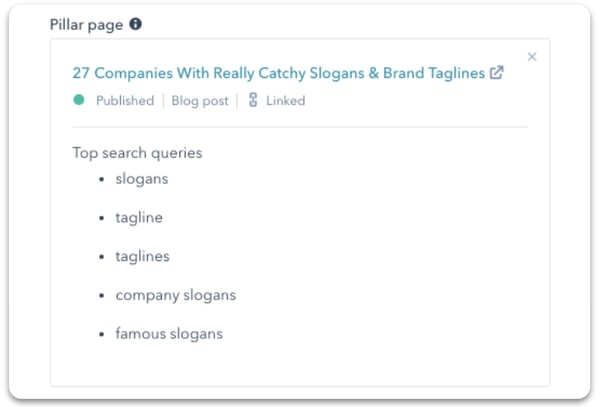We've all heard it before: Search has changed. To succeed today, you need to write engaging and insightful content for people, and optimize it for search engines.

Search data is fundamentally what can help bridge that gap and inform what topics to write about, as well as add context for other related searches.
This shift in search is exactly the reason we introduced the content strategy tool in HubSpot last year, an SEO tool to adapt and plan content around topics. But we've heard a lot of feedback from marketers that there's a piece missing — the ability to get ideas for and report on topically driven keywords.
Today, we're introducing a new integration with Google Search Console that brings actual search data right into HubSpot and makes it easy to create content about a topic. There are three primary ways you can use this integration, which we'll dive into below.
1. Capture an Entire Topic With Related Search Queries
Within a topic, there are distinct subtopics that make up that content. As Nick Fox from Google recently said, "The Topic Layer is built by analyzing all the content that exists on the web for a given topic and develops hundreds and thousands of subtopics."
When you're creating content, it's important to cover the high-level topic, like brand slogans but also some of the prominent sub-topic keywords. Within content strategy in HubSpot, you can now see easily those top search queries. This is important because two people may search for information differently and will likely phrase their query differently. Google has become smart enough to figure this out, which is why we need subtopic keywords to answer every variation of a query.

Google Search Console Top Queries in the Marketing Hub
This means as you create content for an overall topic, you can incorporate subtopic keywords, such as famous slogans above, into the pillar page, or create separate blog posts.
2. See How Your Content Is Performing on Google
With this integration, you can now get three insightful metrics that can help you plan and adjust your strategy. These metrics are available for overall topics on the content strategy dashboard, but are also accessible in content performance so that you can see individual topic-level details. For more detail on how Google thinks about each of these metrics, I recommend reading this article for an in-depth explanation.
- Average Position: The average spot in the list of Google search results where this page appears. The lower the number, the higher your page appears in results. This metric is measured across all device types and countries. If you use another SEO tool, like SEMrush, to measure ranking, than it may appear different because of more granular tracking across device or location.
- Total Impressions: The total number of times this page has shown up in Google search results.
- Average Clickthrough Rate: The total number of times people have clicked on this page in Google search results divided by the total number of times this page has appeared in Google search results.
 Search Console metrics -- like Average Position -- directly in the Marketing Hub
Search Console metrics -- like Average Position -- directly in the Marketing Hub
These metrics can help you see how content is performing much earlier than ever before. With Total Impressions, you can get a sense of whether your content is showing up in search results and if people are seeing it before it ever potentially makes it to the first page of results. From this, you can determine whether it's worth investing in additional internal links and optimizing a page to get more traffic, higher clickthrough rates, and ultimately more conversions.
Chris Zook from Applied Education Systems has been using the Google Search Console integration and it's been helping him save a bunch of time, and making his workday more efficient. Here's what Chris had to say about the integration:
"Professionally, the GSC integration saves me about 15 minutes of back-and-forth every morning. It's not much, but that's about five hours of time freed up every month, so it pays off in a big way!"
"Personally, I love the GSC integration because it's a logical step forward for an all-encompassing CMS & CRM like HubSpot. It just makes sense to have that data all in the same place because I'm already looking at HubSpot while I'm referencing GSC every day."
3. Optimize Content Based on Topically Driven Keywords
One of the reasons the keywords tool in HubSpot was sunsetted back in May was because it relied on exact match keywords, which was an outdated view of how search engines work. Today, with the Google Search Console integration, marketers will be able to see topically driven keywords. This means you can optimize page content and ultimately show up on the first page of search results. Google’s Average Position metric is a better approximation of where you’re showing up because it takes into consideration all the results — those across different devices, geographies, and even personalized searches.

See related search queries on every page and get topically-driven Keywords
This data is now topically relevant and comes directly from Google. As a result, you can rely on it for creating great content that earns interest and gets you found, then measure and refine content over time.
The Google Search Console integration is now live to all customers with HubSpot CMS, Marketing Hub Professional, or Marketing Hub Enterprise. Try out the integration in your HubSpot account today, and let us know what you think.










